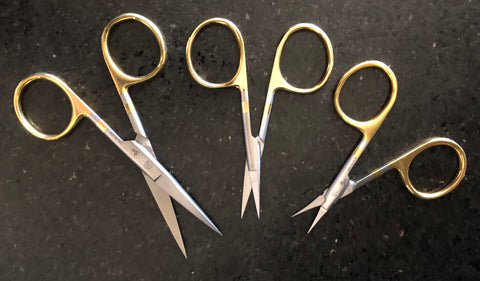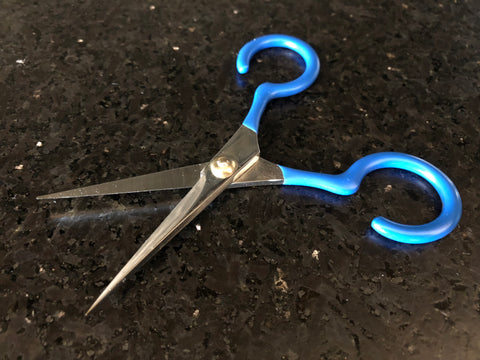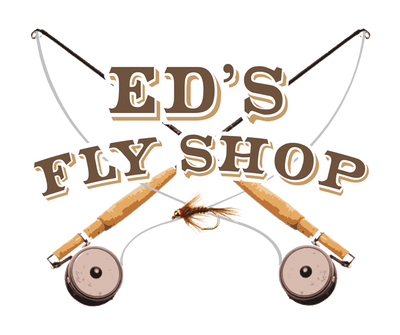Choosing Fly Tying Scissors
There are a lot of fly tying scissors available, and it can be overwhelming to select the right scissors for you. The scissors that you choose needs to be comfortable and allow you to focus on the flies that you're tying. It’s also important to invest in good, quality scissors that will last you a long time.
Blade
Smooth vs Serrated - Smooth blades are good for cutting thread, delicate naturals, synthetics, hair, and material especially when you want a clean edge. Smooth blades have a tendency to push material outward which can make keeping material in place difficult. A good, sharp smooth bladed scissors can help overcome material movement. Serrated blades are dentated blades and are sharp. They are known for being good at gripping material. The idea is that by having less contact area than a smooth blade each point will apply more pressure for a sharp cut. Serrated blades are a good all around scissors and are helpful with cutting silky synthetics and heavy, coarse materials. Both blades serve a purpose, and it’s helpful to determine the type of flies you’ll be tying and the material that you’ll be using.
Short vs Long - Blade lengths generally vary from ½” to 2”. A shorter bladed scissors allows for small and strong cuts such as trimming feathers or cutting thread. Longer blades have less force but allow for large cuts such as cutting elk hair or lengthy material strips.

Straight vs Curved - Straight blades are flat and good at cutting and trimming. Curved blades are curved and work well for precision trimming and cutting curves.

Steel vs Tungsten Carbide - The majority of fly tying scissors are made from various types steel including surgical stainless steel, ice tempered stainless steel, Switzerland stainless steel, and Japaness stainless steel. Quality steel fly tying scissors can provide strength and can last many years. There are also a number of fly tying scissors made of tungsten carbide. Tungsten carbide is a very hard and durable material. In fact, no material other than a diamond can scratch tungsten carbide. Fly tying scissors made of tungsten carbide are expensive, however, they stay sharp and last a long time.
Pivot Points (Pin)
The pivot point or pin is the central point of a scissors and gives the ability for the two handles of a scissors to slide against each other. Generally speaking, the pivot point or pin needs to be tight for good cutting and trimming. Some fly tiers prefer more relaxed tension, depending on what they’re cutting. Most fly tying scissors come with a set tension, however, there are a handful of scissors that have an adjustable tension that allows for tightening or loosening.

Handle & Finger Holes
Handles and finger holes come in many varieties. There are different shaped handles, varied handle and finger hole sizes, and adjustable finger holes. Depending on your hand and habits, make sure the scissor has some give and not too tight on your fingers. Avoid scissors that cramp your hands. What’s most important is that the scissors allows you to keep focused on your flying tying.

Weight
It goes without saying that good, quality scissors have solid weight. They should not be super light nor too heavy. Generally speaking, good scissors are well balanced and well weighted. Be prepared to make the investment for long lasting fly tying scissors.
Types of Scissors (courtesy of Dr.Slick)
Companies such as Anvil, Dr. Slick, and Loon Outdoors make several types of scissors.
Arrow – Short fine-bladed scissor designed for small flies and detail work. The notch at the base of the blades is designed for cutting wire and lead. Excellent for natural materials and can handle most synthetics. Great scissor for in-hand tyers. 3.5" long.
- small, light weight, ability to get in closer, can break more easily when dropped

Hair – Long heavy blades designed for large flies and tough materials. If you work with hair or other heavy materials, this is a true workhorse. Excellent for natural materials and can handle most synthetics. 4.5" long.
- longer blade, can cut more hair

All Purpose – Medium length with blades designed for small, medium and large flies. The one to have in your traveling kit. Excellent for natural materials and can handle most synthetics. 4" long.
- more stability, more durable

Microtip - This series is based on the Big Three, but designed for small delicate detail work. Hypodermic tips on the scissors make short work of very small or lightly dressed flies. Excellent on natural and fine synthetic materials. 3.5", 4", or 4.5" long.

Razor - Possibly the sharpest scissors ever created. Think razor blades with handles. These thin blades with a razor edge make short work of all materials. Adjustable tension allows for loosening or tightening as materials warrant. Cuts through natural and synthetic materials like butter. Made from 440 grade steel. These are the ultimate tying scissors. 4" or 5" long.

Open Loop - Malleable loops allow you to custom contour the scissor loops to your fingers. Excellent with natural materials and can handle most synthetics.

If you tie small flies without much mass or material, use small finer blade scissors like Arrow or MicroTip. Conversely, if you tie larger flies, with more mass and material, consider larger scissors with heavier blades like All Purpose, Hair or Razor.
Petitjean also makes a small, medium, and large scissors consisting of stainless steel in Switzerland.

Remember, great scissors make great flies!
Ed's Fly Shop carries a wide variety of fly tying scissors. Please don't hesitate to call us at (970)372-2395 or send email to info@edsflyshop.com if you have any questions.

